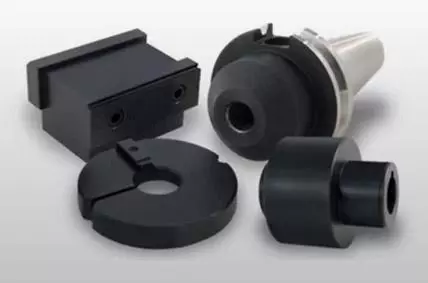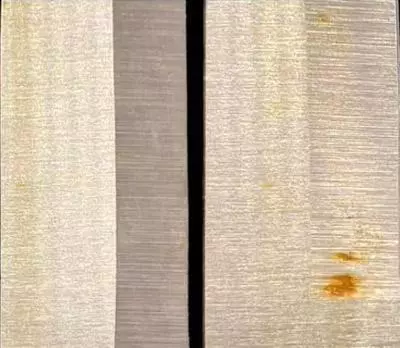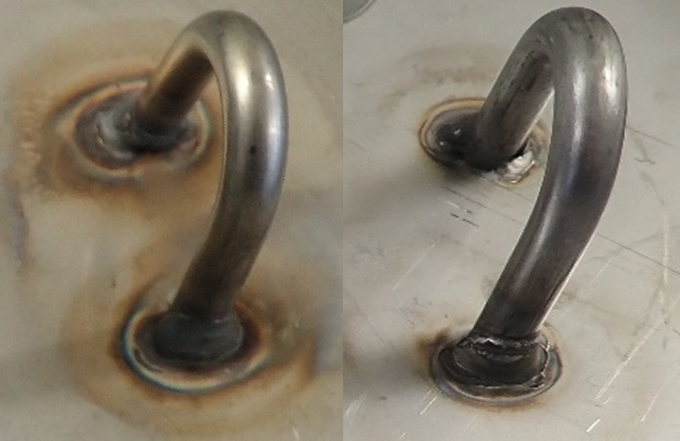What is Passivation and when Passivation is needed
In physical chemistry engineering, it refers to coating a material, so it becomes passive, so that it is not affected or corroded by the environment. Passivation involves the creation of an outer layer of shield material that is applied as a micro coating, created by a chemical reaction with the base material or allowed to build by spontaneous oxidation in the air. As a technique, passivation is the use of a light coat overprotective material such as metal oxide to create a shield against corrosion. Kemet offer Passivation process within Ultrasonic Cleaner automatic lines.
What materials can be passivated
There are quite a few materials that you can passivate.
- Anodizing of Aluminium and Titanium.
- Ferrous materials, such as steel, where you can use conversion coatings such as phosphatizing or black oxidizing, example image opposite of the black oxide treatment.
- Stainless steel which can have a chrome oxide surface.
- Nickel, some applications have Nickel Fluoride.
- Silicone, you have Silicone Dioxide which is used in semiconductor industry.

Passivation of Stainless Steel
How do you passivate stainless steel parts after machining and surface finishing operations to prevent corrosion? In the picture opposite, you have an example of a microscopic image of a machined stainless-steel surface, on the right section, the part is un-passivated and on the left side it is passivated, as you can see, the non-passivated sample has small corrosion spots on the stainless surface.
Passivation is a widely used metal finishing process to prevent corrosion in stainless steel, the passivation process uses nitric acid or citric acid to remove free iron from the surface, the chemical treatment leads to a protective oxide layer that is less likely to chemically react with air and cause corrosion, passivated stainless steel resists rust.
The passivation process is based on standards, and the two most common standards are ASTM A967 and AMS 2700, both originating from the U.S but these are also widely used in Europe too.
These standards have definitions about passivation, ASTM A967 states that the chemical treatment of stainless steel with mild oxidant such as nitric acid for removal of free iron. Another standard, ASTM A380 states that passivation is the removable of exogenous iron or iron compounds from the surface of a stainless steel by means of chemical dissolution, most typically by IO treatment with an acid solution that will remove the surface contamination but will not significantly affect the stainless steel itself for the purpose of enhancing the spontaneous formation of the protective passive film.

History of Passivation
Discovered in the 1850s by a German chemist, Schönbein, who experimented with dipping iron into concentrated nitric acid. He found that the iron had little or no chemical reactivity compared to iron that did not receive the same treatment and named this phenomenon for the lack of chemical reactivity to be the “passive” condition.
Health and safety concerns around passivation of stainless steel with nitric acid resulted in a German company identifying citric acid as an effective alternative, and many manufacturers began to adopt the citric acid process as a safer and more environmentally friendly alternative to nitric acid. Today, standards for passivation offer methods for nitric acid, citric acid or nitric with sodium dichromate - three different options, the choice of method depending on requirements. Each method has its own advantages and disadvantages.
How does Passivation work?
Stainless steel is an iron-based alloy, typically composed of iron nickel and chromium, it derives its corrosion resistant properties from the chrome content, when the chrome is exposed to oxygen, air forms a thin film of chrome oxide that covers the stainless-steel surface and protects the underlying iron from rusting. The purpose of the passivation is to augment and optimize the formation of the chrome oxide layer.
Immersion of stainless steel in an acid bath, dissolves the free iron from the surface, while leaving the chrome intact. The acid chemically removes the free iron leaving behind a uniform surface with a higher proportion of chrome than the underlying material, so the surface becomes chrome rich.
Upon exposure to oxygen in the air after the acid bath, the stainless steel forms the chromic oxide layer over the next 24 to 48 hours, the higher proportion of chrome at the surface, allows for the formation of a thicker more protective chrome oxide layer. Removal of free iron from surface removes opportunities for corrosion to start.
The resulting passive layer provides a chemically non-reactive surface that protects against rust, the thickness of the chrome oxide layer would be just 1-3 nanometres.
Why passivation is required?
It's a post fabrication process that is performed after grinding, welding, cutting and other machining operations that manipulate the stainless steel. Under ideal conditions, stainless steel naturally resists corrosion which might suggest that passivating would be unnecessary, you would consider stainless steel to be stainless, but because of the fabrication processes, it's not necessarily, so under normal conditions, any of the following can inhibit the formation of the oxide film that protects it from corrosion.
- Foreign material in a manufacturing environment
- Shop dirt and grinding swarf
- Airborne contamination
- Sulphides added to the stainless steel for improved machinability
- Certain stainless grades with sulphur content
- Particles of iron from cutting tools that are embedded into the surface of Stainless-Steel parts, so grinding or cutting might introduce iron particles
Such contaminants must be removed down to the surface grain boundaries to restore a uniformly corrosion resistant surface, the passivation process corrects these issues.
Passivation vs Pickling
What is the difference between passivation and pickling? Pickling uses acids that take off the surface of the metal to treat impurities at a sub-level basis, it uses fairly strong acids like hydrofluoric acid which is a really strong acid, pickling leaves a greater change to the metal so it's much more aggressive, while passivation uses the middle milder nitric or citric acid. Passivation is not a method to remove oxide scale, which occurs after welding, pickling is required to remove the oxide scale. Passivation does not typically go below the surface of the metal and does not change the properties of the metal and the oxide layer is very thin.

How to passivate Stainless Steel
The standards which specify processes to passivate stainless steel, titanium, and other materials, nearly all the specifications use the following steps
Firstly, you clean the components, so you remove any contaminants from the surface such as grease and oils, then you passivate, so you perform the chemical treatment by immersion in an acid bath typically nitric or citric acid and thirdly, you would test the components to ensure the effectiveness of the process.
Some Stainless-Steel passivation specifications require adding sodium dichromate to the nitric acid bath to provide more rapid formation of the oxide layer or passivation film. Sodium dichromate, however, is a highly toxic hexavalent chromium compound so as an alternative practice they include use of ultrasonic machines and citric acid to encourage oxygen formation at the metal surface while the material is still immersed in the acid bath so the combination of citric acid and ultrasonic presents a safer and environmentally friendly method.
Treatment tanks are typically in the acid tank for 20 to 30 minutes, temperatures range from room temperature to about 65 degrees Celsius.
Passivation process to prevent corrosion
Typically, you start with alkaline cleaning with ultrasonic to remove all contaminants, oils and other foreign materials. The degreased clean component is then rinsed thoroughly with DI or RO water, then a Nitric or citric immersion bath for the passivation step, to fully dissolve any free irons and sulphites and expedite the formation of passive film or oxide layer, followed by DI water. In high precision industries, typically a cascade or two-step rinsing will follow, then drying and then test the passivation result using salt spray, high humidity etc or validating the passivation processes by the desired quality.
It's important to keep the acid solution free from contaminants, you have some possible phenomena called flash attack which ruins the visual appearance of the parts. Ensure clean water, RO or DI water without chlorides is also important.
Thorough cleaning of the parts before the acid bath, ultrasonic cleaning is a very good way to clean the parts, so having an ultrasonic cleaning stage with alkaline cleaner to start, will guarantee thorough cleanliness before the passivation stage and avoid many problems.
Avoid mixing different steel grades in the batch, typically the tanks and the baskets are made of 316 for consistency so that there's less variance between the grades of the equipment and the materials being treated.
When Passivation is needed?
Due to regulatory requirements, for example in aerospace, medical and food industries, you have a regulatory requirement or equipment made of certain materials to be passivated according to a specific standard and process. In the aerospace industry, the types of components that may require passivation;
- Stainless steel parts
- Actuators
- Hydraulic Actuators
- Landing gear components
- Control rods
- Exhaust components in jet engines
- Cockpit fasteners
In the medical industry, the types of components that may require passivation;
- Orthopaedic implants
- Surgical instruments
- Minimally invasive devices (e.g artificial heart valve)

A range of materials used in the medical industry will require passivation, stainless steel, cobalt chrome, and titanium, to name a few. The Stainless-Steel passivation process has been discussed above; cobalt chrome process is fairly similar to stainless steel. Titanium is also similar with an additional point that nitric acid is used when passivating, to remove any iron or other exogenous materials from the surface and the oxide layer on Titanium forms very quickly when exposed to air, so the reaction is slightly different from Stainless-Steel, but the process is similar.